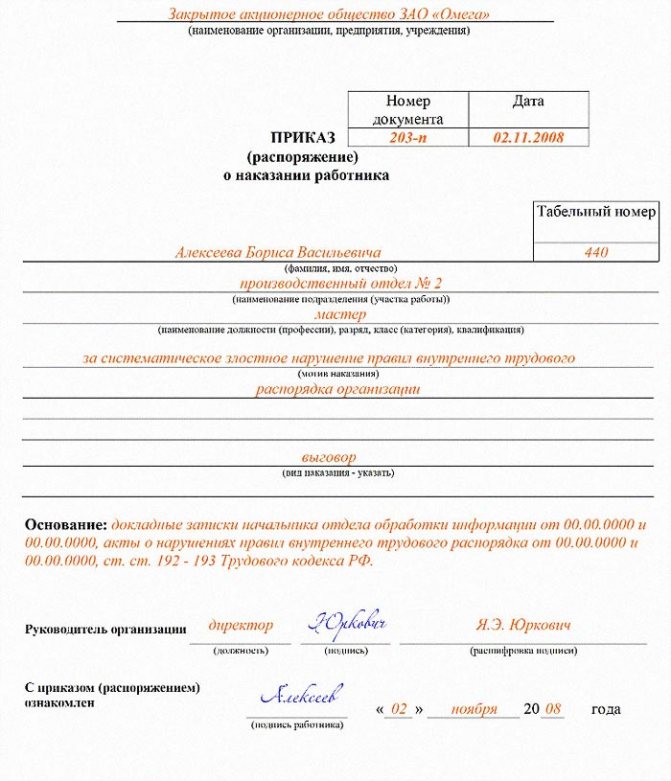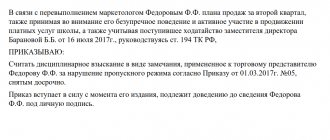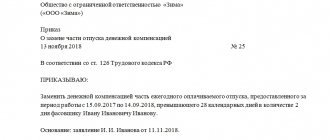In order to correctly draw up an order to punish an employee, a sample related to the important components of the work of the enterprise’s personnel service must be studied. Because any disciplinary sanction against a company employee must be correctly and efficiently executed, documented in the form required by current norms and regulations.
Why is such a seemingly “insignificant” moment, which could be attributed to ordinary cases of everyday work process, given increased attention? Here it must be said that personnel activities in general and disciplinary punishments of employees in particular are an excellent litmus test, an indicator of the development of the enterprise. And this is also one of the most important indicators of the level of social responsibility of the organization’s management.
Forms of punishment
In what cases can a member of the work collective be punished? In order to answer this question, it is worth saying that there are several types of disciplinary sanctions. This is, firstly, a reprimand, secondly, a reprimand, thirdly, dismissal.
It is clear that the first form of punishment is the easiest (relatively, of course). It is often applied to so-called newcomers to the team. This is a good example to demonstrate to a careless specialist and all other employees the mobile response of management to possible flaws of subordinates. This is an excellent way to increase the quality and efficiency of the work performed by the team (because a small and reasonable punishment often stimulates employees to increase productivity and perform their duties more carefully).
As for a reprimand, this is a more serious form of expression of dissatisfaction with an employee by the organization’s management (this is a signal that the employee should reconsider his attitude towards work and perform his job duties more efficiently and carefully).
Dismissal is an extreme measure that top management of enterprises have to take in response to the work of team members that does not meet the requirements.
What exactly are they punished for?

Indeed, for what exactly can an employee receive disciplinary action? We list the most common examples from enterprise practice:
- punishment for an employee may occur after a systematic violation on his part of the organization’s labor regulations (these rules are prescribed, in particular, in the collective agreement, the charter of the enterprise, or the employment contract concluded with the employee);
- They can be punished for frequent and groundless absenteeism, failure to show up at work (without providing relevant medical certificates or other documents confirming the employee’s innocence);
- The reason for this behavior of management is often the constant lateness of subordinates to work;
- An order for punishment may be issued due to the employee’s failure to complete a very important and responsible task, instructions from management, due to disruption of the work process, or due to failure to meet the deadlines for the implementation of any company project that is of strategic importance for its development.
At the same time, management and HR representatives need to clearly understand the following important point. Before a decision is made to issue an order, followed by punishment of the employee, all the reasons for the behavior should be clarified. How to do this? Of course, it will be true if an appropriate conversation is held with the employee, during which the reasons and prerequisites for the current negative situation will be established.
If the employee can clearly explain the true reasons for the violations committed and provide evidence of his innocence (or only indirect guilt), for example, on the basis of illness, management is recommended to more carefully study all the circumstances and make the only correct decision. It would be good if in such a situation the immediate supervisor of the offending employee (for example, a foreman or head of a department) and the employee’s colleagues, who will help to create a complete picture of what happened, will be involved in the consideration of all the details and issues.
Such an integrated approach will help you thoroughly understand all the details. On its basis, a truly adequate final decision will be made.
By the way, this will serve well the management of the enterprise itself. The team will see how carefully the leaders understand what happened, avoiding “tyranny” and hasty conclusions. This will increase the level of trust in top management and improve the corporate climate.
We draw up an order on disciplinary liability in the form of a comment
An order to bring an employee to disciplinary liability in the form of a remark must contain the following information:
- Introductory part:
- Motivational part:
- Resolution part:
- Appendix - grounds for recovery (service memos, acts, etc.).
- Position, as well as personal data of the manager who compiled the document.
- A place for the indicated employee to mark his/her familiarization with this order.
An order on disciplinary liability for a comment can be found by following the link: Sample order on disciplinary liability in the form of a comment.
***
An order to impose disciplinary liability is the final document in which the employer sets out the essence of the type of punishment applicable to the employee for violating labor discipline.
There is no official sample of an order for disciplinary action, with the exception of a form for an order of dismissal, so personnel services have the right to draw them up independently. You can find more complete information on the topic in ConsultantPlus. Free trial access to the system for 2 days.
Document drafting scheme
So, how to correctly issue an order of this type? An approximate example of drawing up an order is as follows.
There is a corresponding form in front of you. Let's start filling it out:
- at the very top of the document the name of the organization is indicated;
- then lower down, on the right, the document number and date are written down (as, in principle, in any standard document, the output of which must be endorsed);
- even lower, already in the center, the name of the document itself is written. Here we note that you can write “instruction” instead of the word “order” (this varies);
- then an indentation is made and the last name, first name, and patronymic of the punished employee are indicated. Along with this, his personnel number (of course, if there is one), the department or division in which the employee works is indicated. The immediate supervisor of this unit (for example, a site foreman) may also be indicated. The name of the position of the offender, his professional rank (if any), category (if any) are written down;
- then the main thing is stated, expressed in the following phrase: “For systematic violation of the organization’s labor regulations.” Of course, this phrase can be recorded in other variations, but this is a standard type of indicating the main purpose of the document;
- then you can indicate the motive for the punishment;
- in addition, the type of punishment is further recorded;
- in the part preceding the final part, the basis for issuing this order is written (for example, memos from the immediate supervisor of the offending employee indicating the relevant numbers and dates; necessary excerpts from the key document, which in this case, of course, is the Labor Code of the Russian Federation);
- The order is “crowned” by the visa of the head of the organization (with the full name of the position), and the signature of the punished employee himself (it is placed under the following phrase: “I have read the order”) and the corresponding date are also required.
We issue an order to bring the employee to disciplinary liability. Sample order
The current legislation does not establish any requirements for the content of an order for disciplinary action, with the exception of the T-8 form (form of an order for dismissal; more information about filling it out in the article Orders on personnel - what are these orders?). But based on practice, the order must contain the following information:
- Introductory part:
- the name of the enterprise whose director issues the order;
- date and number;
- document's name.
- Motivational part:
- reasons for bringing to disciplinary liability, a brief description of the circumstances of the offense;
- information about the employee’s actions;
- provisions of legislative acts, as well as local acts that were violated.
- Resolution part:
- link to articles of the Labor Code of the Russian Federation;
- personal data of the person being held accountable, indicating the position, as well as the structural unit;
- a list of documents that served as the basis for the said proceedings;
- position, as well as personal data of the manager who drew up the order;
- a place for the indicated employee to mark his familiarization with this order.
IMPORTANT! Dismissal does not require drawing up 2 orders: on collection and on dismissal - everything is recorded in one. In the case of drawing up 2 documents, there is a high risk of getting confused in the procedure (for example, not getting a preliminary opinion of the trade union, see the appeal ruling of the RF Supreme Court dated November 9, 2012 No. 60-APG12-7).
An order for disciplinary action can be made by following the link: Sample order for disciplinary action.
What should management remember?
It often happens that a new employee, upon taking up a position, does not undergo thorough procedures for familiarizing himself with the internal rules of the organization.
Yes, they tell him about his job responsibilities, about what tasks he has to perform. But at the same time, very often no training is carried out, during which the employee would be familiar with the rules and regulations that are established within the company, especially regarding disciplinary sanctions.
Even if such briefings are carried out, they look like “idle talk” about not being late for work, fulfilling your duties, and returning on time after your lunch break. But the employee, as a rule, does not receive specific instructions about what types of disciplinary violations exist and what punishments are provided for them.
As a result, the representative of the personnel service (or the representative of the work collective who performs the duties of conducting initial training with newly arriving employees) turns out to be partially to blame for the fact that the employee committed this or that violation. However, the blame is placed entirely on the offender, without taking into account the fact that the employee was simply not familiar with the relevant internal rules and regulations.
The management of organizations and representatives of personnel services should especially take into account this significant factor and provide high-quality preventive training for employees entering the service.
Online magazine for accountants
Every adult has gone to work at least once in their life. Everything begins pleasantly: agreements, obligations, hopes. But anything can happen: sometimes an employee violates his production duties, intentionally or out of ignorance. And then responsibility comes. Disciplinary action: types, grounds Disciplinary measures are applied to an employee for failure to comply with employment agreements and assumed obligations regarding the work schedule, compliance with management orders, compliance with labor safety standards and other nuances of labor relations recognized by law as mandatory. The employer can only choose disciplinary sanctions from the list provided by the Labor Code, and for certain categories of employees - by disciplinary regulations: it is prohibited to invent sanctions on your own. This can happen in the following cases:
- if the employer himself has expressed a desire to reduce the sentence;
- if the employee submitted an application and it was satisfied by the employer;
- if a request was received from the manager of this employee;
- if the request was sent from one of the representative bodies, in particular a trade union.
This is interesting: Order to cancel a reprimand order, sample 2021
In order to release an employee from disciplinary action before the deadline established by law, a corresponding order is usually issued. Each employee should strive to minimize the likelihood of receiving a disciplinary sanction, for which it is enough to simply observe labor discipline and conscientiously perform their duties. Disciplinary sanctions include reprimand, dismissal and some other, less popular in practice, types of sanctions.
To print this document, the company’s letterhead is used, and it must also be registered in a special journal. Sample order for disciplinary action: ORDER November 22, 2016 St. Petersburg In connection with the improper performance by the warehouse manager Kirilenko Maxim Sergeevich of the labor duties that were assigned to him in accordance with employment contract No. 12 dated 04.08. 2015 and the job description of the warehouse manager dated February 15, 2013, which resulted in untimely shipment of goods to the customer, I ORDER: Reprimand the warehouse manager Maxim Sergeevich Kiriyenko. Base:
- Memorandum from the head of the logistics department, Spiridonov A.N. dated 11/15/2016.
- Report on the commission of a disciplinary offense by an employee No. 37 dated November 19, 2016.
- Explanatory note from the employee dated November 16, 2016.
Director of Logistic Enterprise LLC Nikitenko L.P.






